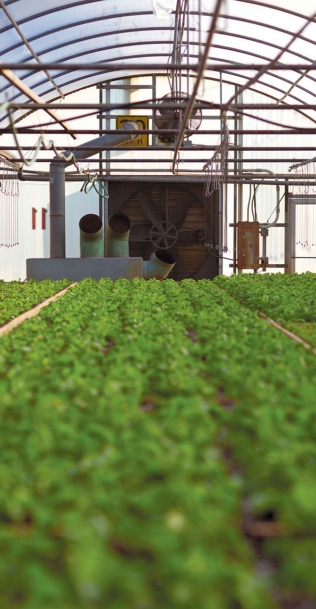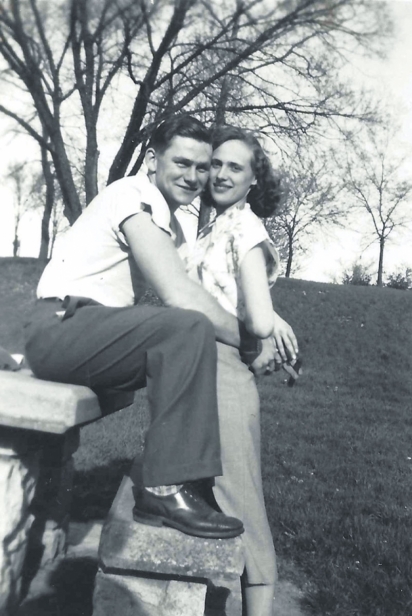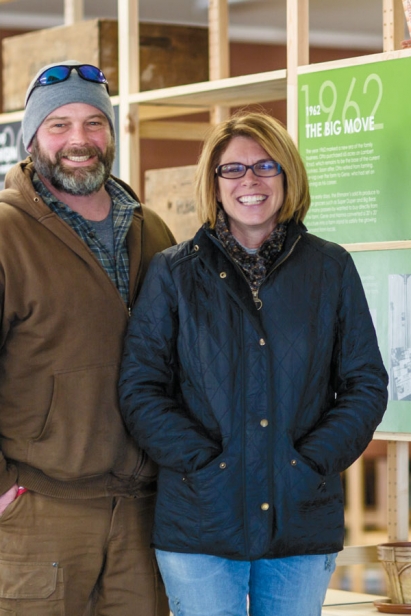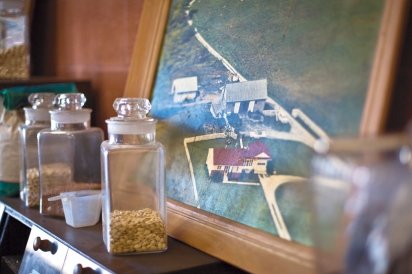Folsom & Pine: From Family Farm to Thriving Local Business
The evolution of a family farm into a thriving local business
For more than 40 years Ehmann & Sons beckoned to the avid gardeners, curious travelers, and aspiring horticulturists of Orient, Ohio. Set just off Lambert Road, the farm is met by the gentle curve of the pavement toward the entry, beckoning. And the greenhouses are advertising alone. Even when the narrow rows are dormant, there is hope for what they will house come spring.
This year, on the same land that proved so valuable to the Ehmanns, Folsom & Pine seeks growth in its second season. Cousins and business owners, Lori Fry and Jeremy Piwer took over their ailing family farm to find an upward trajectory again, to innovate, and, most importantly, to impact the local food community.
Gene and Norma Ehmann bought the 87-acre farm in 1962. They grew vegetables, 38 kinds at the peak. The first greenhouse was erected on the property in 1963. Gene used it to germinate plants from seed, which he found to be more effective than plant starters. He brought in a seeding machine, one of just a handful in the state.
Seeds stuck, but the outcome changed. Through the Farm Aid era and the rise of subsidies for big agriculture, Ehmann & Sons evolved. From produce, they moved on to grow bedding plants and flowers, catering to the uptick in landscaping interest. More greenhouses cropped up, totaling 16 by the mid- 1980s. But time and a shifting industry took its toll. The business, anchored by regulars, saw its first inactive season in 2012.
That’s when cousins Lori and Jeremy, who spent their childhoods on the farm, felt the pull.
“I was born and raised on this farm,” Jeremy says. “I was grandpa’s little shadow.”
Jeremy spoke with his grandparents, Gene and Norma, regularly, but did not know the magnitude of the farm’s needs. He, like Lori, left the area for work, and found more nostalgia than future in the farm. Then the two reconnected for coffee.
“We sit at a Starbucks in Hilliard and he tells me about how the farm is gone,” Lori says. “Without even missing a beat, we turn over a napkin and start figuring out a plan for this place.” She smiles. “It was the most expensive coffee I ever had in my life.”
The two drew up a business plan within a week.
Lori and Jeremy talk about the history of the farm before they discuss its future. Their stories hold great reverence for the man-hours, the creativity, and the risks that came before. This is especially evident as they stand before a visual timeline of the farm’s history that stretches from the immigration of Jeremy’s great-grandfather from Austria-Hungary to an aerial photograph of the land dotted with greenhouses, extended well beyond the original farmhouse. It is a means of bridging the gap between Ehmann & Sons and Folsom & Pine.
“At least the community could come in and we could tell them the story,” Lori says.
In the spring, the retail space will house bulk seed, plants, gardening tools, and goods from other local purveyors like Rhoads Farm and Bluecreek Farm.
Eager to explore the grounds, Lori offers a tour. It’s not a long walk to Greenhouse #7.
Jeremy is already inside. He peels the door back slowly, revealing a slice of green that grows larger and larger. Despite winter’s best efforts, an oasis thrives inside.
Jeremy brushes his palm along the tops of tender microgreens. They are four shades of green, all unbelievably vibrant. “This is where everything starts, in this house right here.”
In this moment, Jeremy is Willy Wonka and the greenhouse, lush and warm and awash in January sun, is a most magical place. Everyone is invited to touch and to taste.
Jeremy navigates the rows of heated benches, set to temperatures specific to each plant. Tomatoes germinate at 70°, arugula between 65° and 67°. He weaves through young arugula plants, stopping to hand out fresh leaves. They are juicy and tender.
He demonstrates how the benches are set on metal rollers, repurposed pieces of old greenhouse, so any one of them could move from side to side for better access.
We stop at a seeding machine that Jeremy brings to life. Miniscule fingers, needle-like, pick up and deposit solitary seeds into trays where they’ll be germinated.
“There’s not an electrical component on that thing. It’s entirely pneumatic,” Lori explains. The seeder runs on forced air rather than electricity or gas.
It is unusual for a farm to grow all of its plants from seed. This seeder at Folsom & Pine is one of only a handful in Ohio. With about 86,000 square feet of workable greenhouse space, it is going to be a vital tool.
Increasing efficiency to fill all those usable acres is a key business driver and overarching goal for Folsom & Pine. Lori, the business-minded half of the operation, knew changes needed to be made that would see a return to produce on the farm.
“These greenhouses were only being used 30– 40% of the year,” Lori says. “You can’t run a business properly with that kind of utilization. So we knew we were going to have to bring edibles back and grow something in these greenhouses again.” The goal for the upcoming year is between 70–80% capacity.
Lori believes “every farmer needs a business person.” With a background in business management consulting, she drives the forecasting.
“You can guess at this stuff but if you guess, you’re going to leave money on the table. We’re in this for the social value of reclaiming the food system, but we have to make money or we’re not going to survive,” she says.
After one more nibble on microgreens with a horseradish kick, Jeremy leads the way to the tomato house. The reveal is no less spectacular. Leafy plants are trellised from floor to ceiling, many bearing tomatoes in various stages of ripeness. The senses are swiftly transported: sweet, vegetal aromas, hazy sunlight, and humid warmth.
“I open that door,” says Jeremy, “and it’s a taste of summer. It’s therapeutic.”
Tomatoes are just one of the vegetables Folsom & Pine grows for the 20+ restaurants it supplies.
Bradley Balch, Executive Chef and Co-Owner of The Sycamore, gets regular deliveries of microgreens, pea shoots, baby arugula, and mizuna, and often features Folsom & Pine’s herbs and tomatoes.
“We want to support the local farmer and they’ve done a great job of offering to me what they have available,” he says. “It’s been a good, very open relationship…and they always have a quality product.”
Chef Bradley describes a dish featured last week with seared scallops and baby heirloom tomatoes. It took diners some convincing, only because they were skeptical of fresh produce in winter. “The guests kept asking, ‘What do you mean you’re getting baby heirloom tomatoes in Ohio in the middle of the January?’”
Jeremy insists we eat as many tomatoes as we can handle. Each is like a glimpse into the future, bursting with flavor. His smile is at its widest point amongst the tomatoes. And he is right back where he started: full of wonder, hands in the dirt, between tall plants on his grandparent’s farm. For Lori and Jeremy, farming Folsom & Pine is a labor of love.
Folsom & Pine; 5959 Lambert Rd, Orient, Ohio 43146; folsomandpine.com; 614-385-4080









